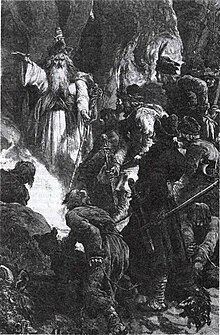
Lizdeika was a semi-legendary pagan priest (krivis) in the 14th-century Grand Duchy of Lithuania. He is associated with the legend of founding of Vilnius recorded in the 16th-century Lithuanian Chronicles.[1] The legend became popular durign the 19th-century romantic nationalism.

According to the legend first recorded in the Bychowiec Chronicle, Grand Duke of Lithuania Gediminas went hunting in the Šventaragis' Valley, fell asleep, and dreamed of a huge howling Iron Wolf. Lizdeika interpreted the dream to mean that a city, which would become the capital of Lithuania, should be founded at the location.[2] The legend probably originated in the early 16th century. Somewhat resembling the legend of Romulus and Remus, it probably reflects the contemporary fashionable theories among the Lithuanian nobility about their Latin origin.[3]
The chronicle also mentioned that Lizdeika was the chief pagan priest (Krivių krivaitis) and that he was found in an eagle's nest (Lithuanian lizdas means nest). Maciej Stryjkowski added additional note that Lizdeika was found in an eagle's nest or, according to others, in a cradle in a tree by Grand Duke Vytenis who raised him as his own son.[4] Various 19th-century authors, including Adam Kirkor and Michal Baliński, claimed that Lizdeika was found in Verkiai, a suburb of Vilnius.[5] Researchers of the Lithuanian mythology, including Vladimir Toporov and Gintaras Beresnevičius, analyzed Lizdeika's origin and noted its shamanistic motifs.[6][7]
Albert Wijuk Kojałowicz (1609–1677) in his armorial of the Grand Duchy of Lithuania and work about the Radziwiłł family identified Lizdeika as a progenitor of the Radziwiłł family. While this genealogy became popular in later centuries, there is no evidence to support it and it is discarded by modern historians.[8]